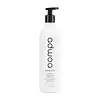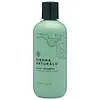What's inside
What's inside
 Key Ingredients
Key Ingredients

No key ingredients
 Benefits
Benefits

 Concerns
Concerns

 Ingredients Side-by-side
Ingredients Side-by-side

Water
Skin ConditioningAloe Barbadensis Leaf Juice
Skin ConditioningCocamidopropyl Betaine
CleansingSodium Cocoyl Isethionate
CleansingLauryl Glucoside
CleansingSodium Lauroyl Lactylate
EmulsifyingGlycerin
HumectantAdansonia Digitata Oil
EmollientRicinus Communis Seed Oil
MaskingPrunus Amygdalus Dulcis Oil
Skin ConditioningGaultheria Procumbens Leaf Oil
MaskingMentha Piperita Oil
MaskingMentha Viridis Leaf Oil
AstringentHydroxyethylcellulose
Emulsion StabilisingPolyquaternium-10
Dehydroacetic Acid
PreservativeBenzyl Alcohol
PerfumingGuar Hydroxypropyltrimonium Chloride
Skin ConditioningOpuntia Ficus-Indica Seed Oil
EmollientCucurbita Pepo Seed Oil
EmollientLavandula Spica Herb Oil
PerfumingRosmarinus Officinalis Leaf Oil
MaskingMenthol
MaskingUrtica Dioica Extract
AstringentCitric Acid
BufferingWater, Aloe Barbadensis Leaf Juice, Cocamidopropyl Betaine, Sodium Cocoyl Isethionate, Lauryl Glucoside, Sodium Lauroyl Lactylate, Glycerin, Adansonia Digitata Oil, Ricinus Communis Seed Oil, Prunus Amygdalus Dulcis Oil, Gaultheria Procumbens Leaf Oil, Mentha Piperita Oil, Mentha Viridis Leaf Oil, Hydroxyethylcellulose, Polyquaternium-10, Dehydroacetic Acid, Benzyl Alcohol, Guar Hydroxypropyltrimonium Chloride, Opuntia Ficus-Indica Seed Oil, Cucurbita Pepo Seed Oil, Lavandula Spica Herb Oil, Rosmarinus Officinalis Leaf Oil, Menthol, Urtica Dioica Extract, Citric Acid
Water
Skin ConditioningAloe Barbadensis Leaf Juice
Skin ConditioningCocamidopropyl Betaine
CleansingSodium Lauroyl Methyl Isethionate
CleansingDecyl Glucoside
CleansingCoco-Glucoside
CleansingGlyceryl Oleate
EmollientGlycerin
HumectantSodium Lauroyl Lactylate
EmulsifyingGuar Hydroxypropyltrimonium Chloride
Skin ConditioningCaprylyl Glycol
EmollientAdansonia Digitata Oil
EmollientCaprylhydroxamic Acid
Lavandula Angustifolia Oil
MaskingPelargonium Graveolens Flower Oil
MaskingTocopherol
AntioxidantCitric Acid
BufferingSodium Chloride
MaskingWater, Aloe Barbadensis Leaf Juice, Cocamidopropyl Betaine, Sodium Lauroyl Methyl Isethionate, Decyl Glucoside, Coco-Glucoside, Glyceryl Oleate, Glycerin, Sodium Lauroyl Lactylate, Guar Hydroxypropyltrimonium Chloride, Caprylyl Glycol, Adansonia Digitata Oil, Caprylhydroxamic Acid, Lavandula Angustifolia Oil, Pelargonium Graveolens Flower Oil, Tocopherol, Citric Acid, Sodium Chloride
Ingredients Explained
These ingredients are found in both products.
Ingredients higher up in an ingredient list are typically present in a larger amount.
Baobab oil is an emollient. This ingredient is rich in fatty acids, mostly oleic acid, linoleic acid, palmitic acid.
Due to this fatty acid content, this ingredient may not be fungal-acne safe.
Fun fact: Our skin uses fatty acids, and especially linoleic acid, for creating ceramides.
Aloe Barbadensis Leaf Juice comes from leaves of the aloe plant. Aloe Barbadensis Leaf Juice is best known for helping to soothe sunburns. It is also anti-inflammatory, moisturizing, antiseptic, and can help heal wounds.
Aloe is packed with good stuff including Vitamins A, C, and E. These vitamins are antioxidants, which help fight free-radicals and the damage they may cause. Free-radicals are molecules that may damage your skin cells, such as pollution.
Aloe Barbadensis Leaf Juice also contains sugars. These sugars come in the form of monosaccharides and polysaccharides, folic acid, and choline. These sugars are able to help bind moisture to skin.
It also contains minerals such as calcium, 12 anthraquinones, fatty acids, amino acids, and Vitamin B12.
Learn more about Aloe Barbadensis Leaf JuiceCitric Acid is an alpha hydroxy acid (AHA) naturally found in citrus fruits like oranges, lemons, and limes.
Like other AHAs, citric acid can exfoliate skin by breaking down the bonds that hold dead skin cells together. This helps reveal smoother and brighter skin underneath.
However, this exfoliating effect only happens at high concentrations (20%) which can be hard to find in cosmetic products.
Due to this, citric acid is usually included in small amounts as a pH adjuster. This helps keep products slightly more acidic and compatible with skin's natural pH.
In skincare formulas, citric acid can:
While it can provide some skin benefits, research shows lactic acid and glycolic acid are generally more effective and less irritating exfoliants.
Most citric acid used in skincare today is made by fermenting sugars (usually from molasses). This synthetic version is identical to the natural citrus form but easier to stabilize and use in formulations.
Read more about some other popular AHA's here:
Learn more about Citric AcidCocamidopropyl Betaine is a fatty acid created by mixing similar compounds in coconut oil and dimethylaminopropylamine, a compound with two amino groups.
This ingredient is a surfactant and cleanser. It helps gather the dirt, pollutants, and other impurities in your skin to be washed away. It also helps thicken a product and make the texture more creamy.
Being created from coconut oil means Cocamidopropyl Betaine is hydrating for the skin.
While Cocamidopropyl Betaine was believed to be an allergen, a study from 2012 disproved this. It found two compounds in unpure Cocamidopropyl Betaine to be the irritants: aminoamide and 3-dimethylaminopropylamine. High-grade and pure Cocamidopropyl Betaine did not induce allergic reactions during this study.
Learn more about Cocamidopropyl BetaineGlycerin is already naturally found in your skin. It helps moisturize and protect your skin.
A study from 2016 found glycerin to be more effective as a humectant than AHAs and hyaluronic acid.
As a humectant, it helps the skin stay hydrated by pulling moisture to your skin. The low molecular weight of glycerin allows it to pull moisture into the deeper layers of your skin.
Hydrated skin improves your skin barrier; Your skin barrier helps protect against irritants and bacteria.
Glycerin has also been found to have antimicrobial and antiviral properties. Due to these properties, glycerin is often used in wound and burn treatments.
In cosmetics, glycerin is usually derived from plants such as soybean or palm. However, it can also be sourced from animals, such as tallow or animal fat.
This ingredient is organic, colorless, odorless, and non-toxic.
Glycerin is the name for this ingredient in American English. British English uses Glycerol/Glycerine.
Learn more about GlycerinThis ingredient is derived from guar gum.
It is a conditioning ingredient, meaning it helps soften skin and hair.
Sodium Lauroyl Lactylate is the lauric acid sodium salt of lactyl lactate.
Sodium Lauroyl Lactylate is an emulsifier and surfactant.
Emulsifiers help stabilize a product. They do this by preventing ingredients from separating, such as oils and water which do not mix naturally. Surfactants reduce surface tension, making it easier to rinse pollutants off skin.
Due to its relation to lauric acid, it may provide antimicrobial benefits.
Learn more about Sodium Lauroyl LactylateWater. It's the most common cosmetic ingredient of all. You'll usually see it at the top of ingredient lists, meaning that it makes up the largest part of the product.
So why is it so popular? Water most often acts as a solvent - this means that it helps dissolve other ingredients into the formulation.
You'll also recognize water as that liquid we all need to stay alive. If you see this, drink a glass of water. Stay hydrated!
Learn more about Water